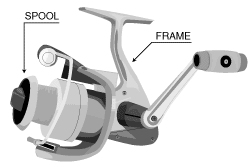Nov 26, 2024
Freshwater Reels
From spool to gear ratio, from frames to bearings, our guide explains all you need to know to select your reel.
How To Buy Freshwater Reels
Finding a good reel starts with three basic considerations: your experience, your preferred way of fishing and the type of fish you are after. You then have a choice of several styles of reels to get the job done.
How to buy freshwater reels
Types
There are basically three types of reels to consider, each with advantages to weigh:baitcasting, spinning and spincasting.
- Baitcasting reels
- Baitcasting reels work with the weight of the bait or lure as it pulls on the line and turns the spool to release more line. The heavier the lure, the longer the cast.
- With practice, this style of reel also will allow you to cast more accurately
- These are typically preferred by more experienced anglers, especially when using heavier lures and lines designed for bigger fish
- Most baitcasting reels now incorporate a drag system designed to adjust theresistance--or drag--on the spool to control how much resistance is needed to pull the right amount of line off the spool. Star drags or a simple drag knob is common.
- You can also select a baitcasting reel for your style of fishing
- Offshore reels are designed to fight large fish from a boat
- Trolling reels allow you to drag live bait or a lure as you troll in a boat
- Casting reels give you the benefit of precision casts
- These even come in casting styles, with pitching to cast overhead or sidearm and flipping to cast underhand in tight situations such as underneath tree branches
- Spinning reels
- Spinning reels are open-faced
- Your line is released from a stationary spool by flipping a bail wire, a piece of metal wire across the spool called a bail
- This stationary spool keeps the line in place and helps prevent snarls and tangled line
- The weight of your lure or bait propels the line forward
- Spinning reels can handle smaller bait but today's spinning reels are designed for light to heavier fish
- You also need to ensure that your reel is a left- or right-hand retrieve, or can be adapted for either hand
- Spinning reels use an anti-reverse, a simple mechanism you set by letting go of the bail wire after casting. This keeps your line from spooling off once you get a strike from a fish.
- The anti-reverse lock is usually a lever mounted on the gear housing cover
- It prevents the reel handle from turning in reverse when you hook a fish and it runs or when you are trolling
- Automatic anti-reverse requires no manual settings
- Spincasting reels
- Spincasting reels are closed-faced, and combine spinning and casting. The spool remains stationary until you use a thumb button to cast. When you release the button, your bait or lure propel your line.
- The ease of spincasting reels make them a good choice for beginners both for the in ease of casting and their reliability, with few bells and whistles that cause problems while your fishing
- The closed face does limit line capacity, but you can still find models that will handle light to medium fish

- Spools
- The spool is the part of the reel that holds the line
- It is a detachable component of the reel
- Spools are made of either graphite or aluminum
- Graphite spools are designed to be lighter than aluminum spools
- Aluminum spools generally cost more and some consider aluminum to be more durable
- Either material is designed to resist corrosion from the water
- Frames
- The frame is what gives a real its shape
- Frames can also be either made of graphite or aluminum
- Once again, this is a question of weight and the price you are willing to pay for a reel
- Line capacity
- Line capacity is a key consideration in selecting a reel
- Reels can handle as little as 15 yards to as much as 900 yards
- The amount of line you'll need depends on your fishing. For example, fishing in your favorite pond or park will probably require only minimal line capacity. If you plan on fishing in the Great Lakes, though, you may need more line capacity to handle the water's depth and the type of fish that may run with your line.
- Gear ratio
- Gear ratios tells you how quickly a reel will retrieve line per revolution of your reel's crank
- As a guide, lower ratios provide more power for bringing fish from deeper depths, while higher gear rations benefit when pulling fish from closer to the surface
- Ball bearings
- Ball bearings are used to help reels work more smoothly by supporting the moving parts
- Generally speaking, the more ball bearings, the smoother the reel works, especially under pressure
- As more ball bearings are added to a reel, the cost goes up
How to buy combos
- If you are new to fishing, combos are a great way to start because manufacturers match the right reel with the right rod. They usually even put the right line on the reel for you.
- All you need to do is determine the type of fishing that you want to do and then find the combo that best suits your needs
- Like anything else, the more features in a combo, as well as the more quality components, the more you will pay. A good combo, though, can provide a lifetime of fun.